描述
阻燃ABS树脂
建筑装饰业
交通运输业、广告业
电气、化工机械、汽车业
阻燃ABS树脂
产品详细信息
阻燃ABS树脂
降低ABS树脂可燃性的方法主要有三种:
<使用阻燃聚合物,如CPE和PVC,与ABS混合;2.对现有ABS进行化学改性,如添加三溴苯乙烯作为第四单体,制成四组分ABS;3.使用常规方法向ABS中添加阻燃剂,如无机阻燃剂(如MoO3)和有机阻燃剂(如卤素化合物、磷阻燃剂)。虽然阻燃剂提供了高效阻燃功能,但可能缺乏其他特性(如老化、成本高)。化学改性ABS需要一种更难的独特制造方法。第三种技术在成本和性能之间找到了平衡,同时也为多功能材料设计提供了更大的灵活性。在ABS材料中添加高效含卤阻燃剂是目前最常用的阻燃改性方法
通过降低橡胶含量、增加SAN分子量和丙烯腈含量,可以提高ABS的耐热性,但通过添加耐热单体或耐热添加剂来开发耐热ABS的方法越来越受到关注。耐热ABS树脂的热变形温度一般为90~105℃,具有良好的耐热性、韧性和流动性。可用于生产车门、后轮罩内板、面板等,也可用于家用电器领域,如微波炉、电饭煲、吹风机等。在ABS树脂中引入α-甲基苯乙烯(MS)、马来酸酐(MA)和马来酰亚胺(MI)可提高ABS的耐热性。主要有两种方式:
-
1。以MS、MI等为第三单体,与苯乙烯、丙烯腈共聚,提高基体树脂的刚性,提高Tg。MA和AN共聚物的耐热性比相同AN含量的SAN好,维卡软化温度分别为123°C和103°C。两者的耐化学性和物理性能相似,生产方法也很常见。MS基材料的颜色比苯乙烯基材料的颜色更黄。在实际生产中,MS仅部分取代苯乙烯获得SMSAN共聚物。更换率取决于耐热性的要求
-
-
2。将耐热性更好的苯乙烯-马来酸酐共聚物(SMA)或苯乙烯-马来酰亚胺共聚物(SMI)作为共混组分添加到ABS树脂中。SMA的维卡软化点温度可达150℃。然而,SMA在较高温度下不稳定。二氧化碳将被释放,因此必须将其释放,使其保持足够稳定,并可在260°C以下进行处理,否则零件将具有辐射模式。在SMA中加入1%受阻酚类抗氧剂和硫酯增效剂,可使SMA稳定。SMI可用于耐热性高于SMA和MS的场合。苯乙烯与MI共聚的生产工艺与SAN相同。SMA与氨或胺反应进行亚胺化,也可以制备SMI。SMI在高温下具有良好的热稳定性,不会产生辐射图案
-
联系我们
Flame-retardant ABS Resin
Architecture Decoration Industry
Transportation Industry, Advertisement Industry
Electric & Electrical, Chemical Machinery,
Automobile Industry
Flame-retardant ABS Resin
Product Details
Flame-retardant ABS resin
There are three major methods for reducing ABS resin combustibility:
-
Use flame retardant polymers, such as CPE and PVC, to mix with ABS; 2. Chemical modification of existing ABS, such as adding tribromostyrene as the fourth monomer to make four-component ABS; 3. Add flame retardants to ABS using conventional methods, such as inorganic flame retardants (such as MoO3) and organic flame retardants (such as halogen compounds, phosphorus flame retardants). Although the flame-retardant kind provides a high-efficiency flame-retardant function, other characteristics may be lacking (such as aging, high cost). Chemically modified ABS necessitates a unique manufacturing method that is more difficult. The third technique finds a balance between cost and performance while also allowing for more flexibility in multifunctional material design. Adding high-efficiency halogen-containing flame retardants to ABS materials is now the most common method of flame retardant modification.
-
The heat resistance of ABS can be improved by reducing rubber content, increasing SAN molecular weight and acrylonitrile content, but the method of adding heat-resistant monomers or heat-resistant additives to develop heat-resistant ABS has attracted more attention. The heat distortion temperature of heat-resistant ABS resin is generally 90~105°C, which has good heat resistance, toughness and fluidity. It can be used in the production of car doors, rear wheel cover inner panels, panels, etc., and used in the field of home appliances, such as microwave ovens, rice cookers, hair dryers, etc. The introduction of α-methylstyrene (MS), maleic anhydride (MA) and maleimide (MI) into ABS resin can improve the heat resistance of ABS. There are two main ways:
-
1. Use MS, MI, etc. as the third monomer to copolymerize with styrene and acrylonitrile to increase the rigidity of the matrix resin and increase its Tg. The copolymer of MA and AN has better heat resistance than SAN with the same AN content, and its Vicat softening temperature is 123°C and 103°C, respectively. The chemical resistance and physical properties of the two are similar, and the production method is also common. The color of MS-based materials is yellower than that of styrene-based materials. In actual production, MS only partially replaces styrene to obtain SMSAN copolymer. The replacement ratio depends on the requirements of heat resistance.
-
2. The styrene-maleic anhydride copolymer (SMA) or styrene-maleimide copolymer (SMI) with better heat resistance is added to the ABS resin as a blend component. The Vicat softening point temperature of SMA can reach 150℃. However, SMA is unstable at higher temperatures. Carbon dioxide will be released, so it must be released so that it remains stable enough and can be processed below 260°C, otherwise the parts will have radiation patterns. Adding 1% hindered phenol antioxidant and thioester synergist to SMA can stabilize it. SMI can be used in situations where heat resistance higher than that SMA and MS can provide. The production process of copolymerization of styrene and MI is the same as that of SAN. SMA reacts with ammonia or amine to be imidized, and SMI can also be prepared. SMI has good thermal stability at high temperatures and does not produce radiation patterns.
ContactnowformoredetailsaboutFlame-retardant ABS resin.
Kitty Liu< ###>
is one of the professional flame-retardant abs resin manufacturers, you can order high quality flame-retardant abs resin at good price from our factory.
阻燃ABS树脂
降低ABS树脂可燃性的方法主要有三种:
- <使用阻燃聚合物,如CPE和PVC,与ABS混合;2.对现有ABS进行化学改性,如添加三溴苯乙烯作为第四单体,制成四组分ABS;3.使用常规方法向ABS中添加阻燃剂,如无机阻燃剂(如MoO3)和有机阻燃剂(如卤素化合物、磷阻燃剂)。虽然阻燃剂提供了高效阻燃功能,但可能缺乏其他特性(如老化、成本高)。化学改性ABS需要一种更难的独特制造方法。第三种技术在成本和性能之间找到了平衡,同时也为多功能材料设计提供了更大的灵活性。在ABS材料中添加高效含卤阻燃剂是目前最常用的阻燃改性方法
-
1。以MS、MI等为第三单体,与苯乙烯、丙烯腈共聚,提高基体树脂的刚性,提高Tg。MA和AN共聚物的耐热性比相同AN含量的SAN好,维卡软化温度分别为123°C和103°C。两者的耐化学性和物理性能相似,生产方法也很常见。MS基材料的颜色比苯乙烯基材料的颜色更黄。在实际生产中,MS仅部分取代苯乙烯获得SMSAN共聚物。更换率取决于耐热性的要求
-
2。将耐热性更好的苯乙烯-马来酸酐共聚物(SMA)或苯乙烯-马来酰亚胺共聚物(SMI)作为共混组分添加到ABS树脂中。SMA的维卡软化点温度可达150℃。然而,SMA在较高温度下不稳定。二氧化碳将被释放,因此必须将其释放,使其保持足够稳定,并可在260°C以下进行处理,否则零件将具有辐射模式。在SMA中加入1%受阻酚类抗氧剂和硫酯增效剂,可使SMA稳定。SMI可用于耐热性高于SMA和MS的场合。苯乙烯与MI共聚的生产工艺与SAN相同。SMA与氨或胺反应进行亚胺化,也可以制备SMI。SMI在高温下具有良好的热稳定性,不会产生辐射图案
-
联系我们
Flame-retardant ABS Resin
Architecture Decoration Industry
Transportation Industry, Advertisement Industry
Electric & Electrical, Chemical Machinery,
Automobile IndustryFlame-retardant ABS Resin
Product Details
Flame-retardant ABS resin
There are three major methods for reducing ABS resin combustibility:
-
Use flame retardant polymers, such as CPE and PVC, to mix with ABS; 2. Chemical modification of existing ABS, such as adding tribromostyrene as the fourth monomer to make four-component ABS; 3. Add flame retardants to ABS using conventional methods, such as inorganic flame retardants (such as MoO3) and organic flame retardants (such as halogen compounds, phosphorus flame retardants). Although the flame-retardant kind provides a high-efficiency flame-retardant function, other characteristics may be lacking (such as aging, high cost). Chemically modified ABS necessitates a unique manufacturing method that is more difficult. The third technique finds a balance between cost and performance while also allowing for more flexibility in multifunctional material design. Adding high-efficiency halogen-containing flame retardants to ABS materials is now the most common method of flame retardant modification.
-
The heat resistance of ABS can be improved by reducing rubber content, increasing SAN molecular weight and acrylonitrile content, but the method of adding heat-resistant monomers or heat-resistant additives to develop heat-resistant ABS has attracted more attention. The heat distortion temperature of heat-resistant ABS resin is generally 90~105°C, which has good heat resistance, toughness and fluidity. It can be used in the production of car doors, rear wheel cover inner panels, panels, etc., and used in the field of home appliances, such as microwave ovens, rice cookers, hair dryers, etc. The introduction of α-methylstyrene (MS), maleic anhydride (MA) and maleimide (MI) into ABS resin can improve the heat resistance of ABS. There are two main ways:
-
1. Use MS, MI, etc. as the third monomer to copolymerize with styrene and acrylonitrile to increase the rigidity of the matrix resin and increase its Tg. The copolymer of MA and AN has better heat resistance than SAN with the same AN content, and its Vicat softening temperature is 123°C and 103°C, respectively. The chemical resistance and physical properties of the two are similar, and the production method is also common. The color of MS-based materials is yellower than that of styrene-based materials. In actual production, MS only partially replaces styrene to obtain SMSAN copolymer. The replacement ratio depends on the requirements of heat resistance.
-
2. The styrene-maleic anhydride copolymer (SMA) or styrene-maleimide copolymer (SMI) with better heat resistance is added to the ABS resin as a blend component. The Vicat softening point temperature of SMA can reach 150℃. However, SMA is unstable at higher temperatures. Carbon dioxide will be released, so it must be released so that it remains stable enough and can be processed below 260°C, otherwise the parts will have radiation patterns. Adding 1% hindered phenol antioxidant and thioester synergist to SMA can stabilize it. SMI can be used in situations where heat resistance higher than that SMA and MS can provide. The production process of copolymerization of styrene and MI is the same as that of SAN. SMA reacts with ammonia or amine to be imidized, and SMI can also be prepared. SMI has good thermal stability at high temperatures and does not produce radiation patterns.
ContactnowformoredetailsaboutFlame-retardant ABS resin.
Kitty Liu< ###>
is one of the professional flame-retardant abs resin manufacturers, you can order high quality flame-retardant abs resin at good price from our factory.
-
通过降低橡胶含量、增加SAN分子量和丙烯腈含量,可以提高ABS的耐热性,但通过添加耐热单体或耐热添加剂来开发耐热ABS的方法越来越受到关注。耐热ABS树脂的热变形温度一般为90~105℃,具有良好的耐热性、韧性和流动性。可用于生产车门、后轮罩内板、面板等,也可用于家用电器领域,如微波炉、电饭煲、吹风机等。在ABS树脂中引入α-甲基苯乙烯(MS)、马来酸酐(MA)和马来酰亚胺(MI)可提高ABS的耐热性。主要有两种方式:





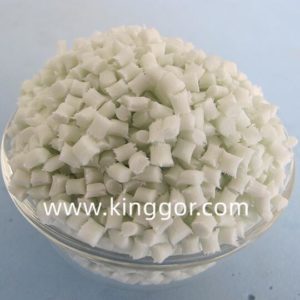



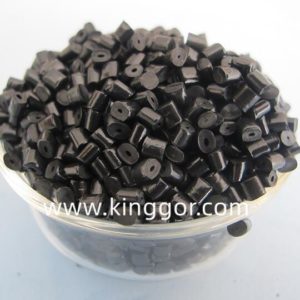

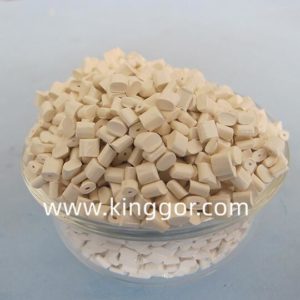
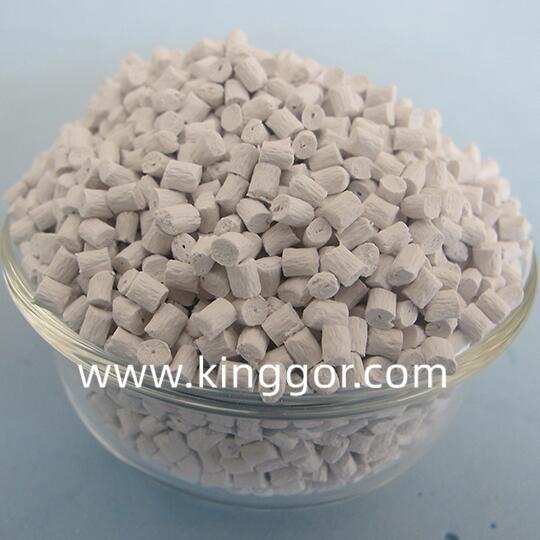

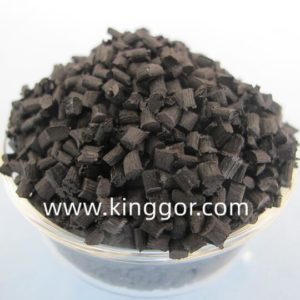
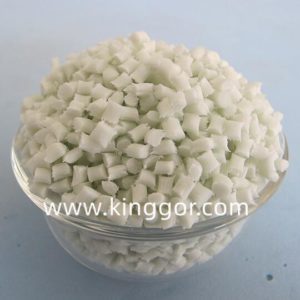




评价
目前还没有评价